It’s no secret that every Limited format has its fair share of under- and over-valued cards. Theros is no exception. In fact, Theros has more seemingly bad and good cards than most Limited sets I’ve ever played. As usual, it’s all about the context of the rest of the set. Before getting into specific cards from Theros, let’s take a look at a few examples.
As a very basic example, if most playable creatures in a Limited format have four toughness, then the usually awesome Searing Spear starts looking a little less hot. Let’s go one level deeper and look at a card like Leyline Phantom.
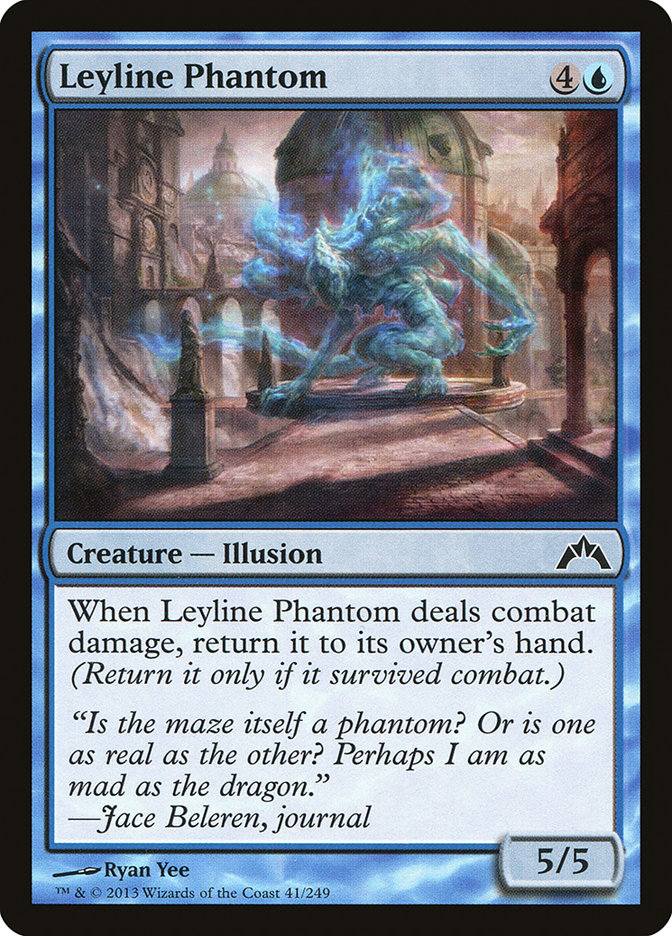 Sure, a five-mana 5/5 is pretty big, but when I first saw it I thought it was laughably bad. I even went as far as to mock it with a bunch of friends at the Gatecrash prerelease, quoting the usual Magic player go-to: “Why do they even print cards this bad?” In this case, it turned out that the joke was on me. All it took was one game of me watching a Leyline Phantom repeatedly hit play, triggering multiple Evolve creatures turn after turn, to realize my first analysis was off. In the context of the Evolve-laden Gatecrash Limited, Leyline Phantom went from joke to role-player in my book rather quickly.
Sure, a five-mana 5/5 is pretty big, but when I first saw it I thought it was laughably bad. I even went as far as to mock it with a bunch of friends at the Gatecrash prerelease, quoting the usual Magic player go-to: “Why do they even print cards this bad?” In this case, it turned out that the joke was on me. All it took was one game of me watching a Leyline Phantom repeatedly hit play, triggering multiple Evolve creatures turn after turn, to realize my first analysis was off. In the context of the Evolve-laden Gatecrash Limited, Leyline Phantom went from joke to role-player in my book rather quickly.
Now turn the clock back a little further to Return to Ravnica Limited. This set had its own metagame in terms of card evaluation! Right from the beginning I saw people picking cards like Dryad Militant, Rakdos Cackler, and Azorius Arrester fairly high in draft. However, Return to Ravnica featured a ton of playable defensive bodies that punished aggressive creatures.
The set included Lobber Crew, Trestle Troll, Hussar Patrol, Towering Indrik, and Doorkeeper as cards that were great at slowing aggressive decks down. As we know now, four was the magic number for power and toughness. Because of this, any creature with two or three power threatened to become useless very early on in the game. As the set was drafted more and more, people began to leave the smaller creatures on the sidelines in favor of defensive card and cards that went over the top.
Then something incredibly interesting happened. People began to realize there was more than one way to combat all these X/4’s: just go straight through them. Using a pump spell on your 2/2 to kill an 0/4 will do nothing to help it get through the next defensive creature that comes down. However, putting Deviant Glee or Pursuit of Flight on your 2/2 will make every 0/4 that tries to get in its way quite embarrassing. Towards the twilight of triple RTR draft, I saw more and more people reverting back to the scrappy aggressive creatures except that this time they were backed by usually-maligned auras to make sure a couple of walls wouldn’t end their relevance.
Let’s take a quick recap.
Phase One: Players value aggressive creatures as per norm and get punished by cheap, effective defensive creatures.
Phase Two: Players start to value defensive creatures and ways to go over the top very highly.
Phase Three: Players go back to drafting aggressive creatures, now backed by cheap auras and tricks to ensure they don’t get walled out and can win the game before the over-the-top strategies come into play.
It’s weird to think of a Limited format as having an evolving metagame but that’s exactly what happened when it came to Return to Ravnica.
Now that we’ve got a solid outline for card evaluation and context, it’s time to bring things back to Theros. Let’s kick things off with the undervalued cards:
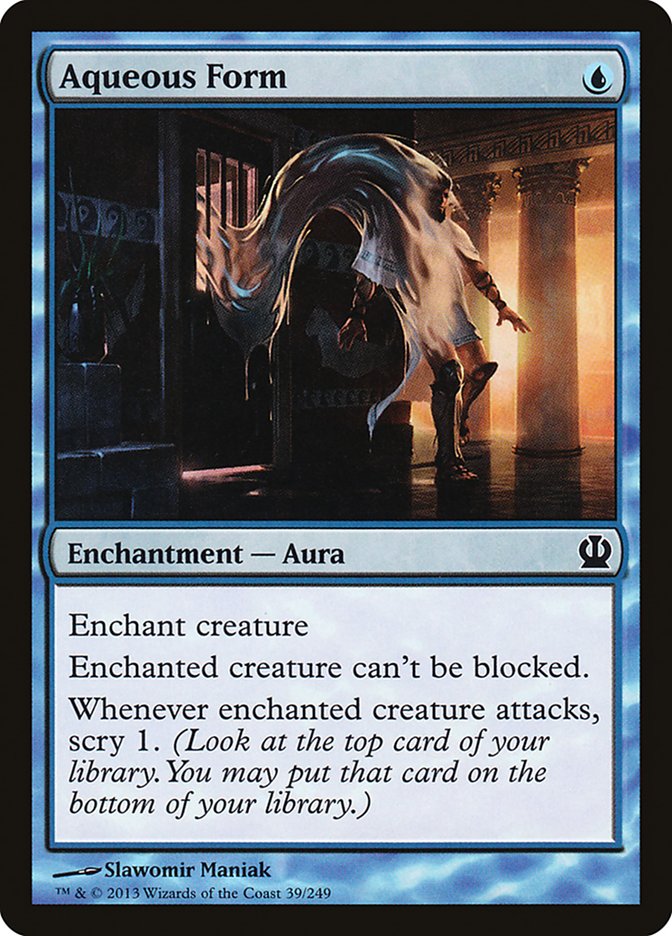
Context: Huge non-evasive creatures and a lack of removal
When I first looked over the spoiler for Theros, I brushed right over Aqueous Form as unplayable garbage not worth my time. As I started to play a few drafts, however, I began to see some of the potential in it. Between acting as a heroic trigger and the low amount of removal in the set, I started to look at is as a twenty-third card and even talked about it as such a few weeks ago.
After having some more time to play both with and against the card, I’ve fallen head over heels for it. There’s no better way to learn just how good a card is than by losing to it repeatedly. If you slap an Aqueous Form on a 3/3 or 4/4 creature, that creature will kill your opponent pretty darn fast. Because of Heroic, Bestow, and Monstrosity, one of the defining facets of this format is creating one giant threat and riding it to victory. Getting a 10/10 chump blocked sucks, so it would make sense that making that 10/10 unblockable instead is awesome. Scrying into cards that let you stall the game out until your unblockable monster goes all the way ties it all together.
With Aqueous Form, the bigger the creature the better it is. I will always try to aggressively pick one up if I’m playing a blue creature deck, but it really shines in blue-green where you have great targets like Staunch-Hearted Warrior and Nessian Asp. In that archetype, I’m aiming to get two copies.
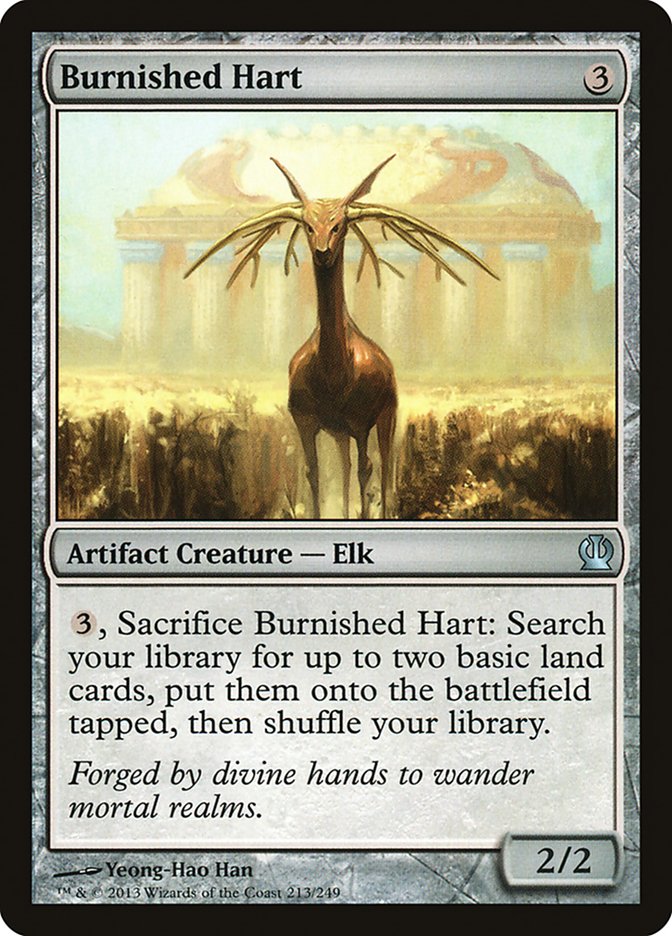
Context: Mana sinks and auras
A six-mana Explosive Vegetation isn’t that great. A Gray Ogre is also nothing to gawk at. However, when you combine two lesser effects on one card things get more enticing. On top of the face-value versatility you get from this Elk, both halves are better than they would normally be. Need extra mana for Monstrosity or Bestow? Sacrifice it and find some land. Need a body to Bestow upon? A Gray Ogre isn’t insane, but it’s something. I’ve been very happy with the work Burnished Hart puts in and have been taking it higher and higher the more I draft.
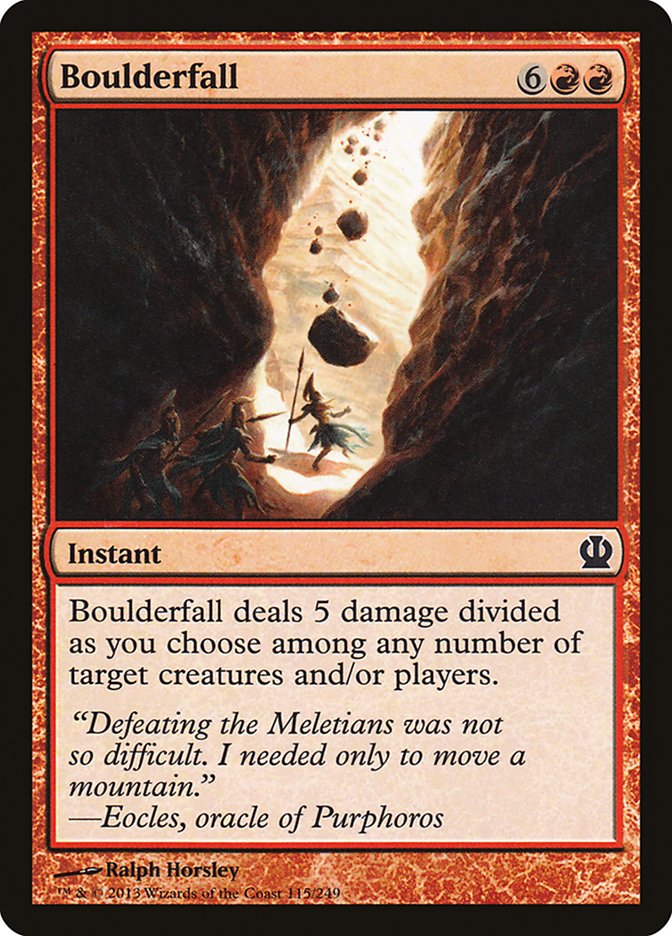
Context: Large amounts of mana ramp
First things first – I think we can all agree Boulderfall is an underpowered card. When I pay eight mana for a spell, I’m usually looking to get more than a slightly-better Violent Eruption. However, power level and playability are two totally different metrics. In green, we have access to Karametra’s Acolyte, Burnished Hart, Sylvan Caryatid, Ordeal of Nylea, and Voyaging Satyr, all which provide extra mana. You’re looking to hit six to seven mana in these decks anyway, so jumping up to eight isn’t a huge difference.
I’ll admit that I wasn’t really a believer in this card for a long time. The thing that really pushed me over the edge was the advice and actions of my teammate Chris Fennell. In the first draft at the Pro Tour he barely missed going 3-0 with a draft deck featuring three copies of Boulderfall.
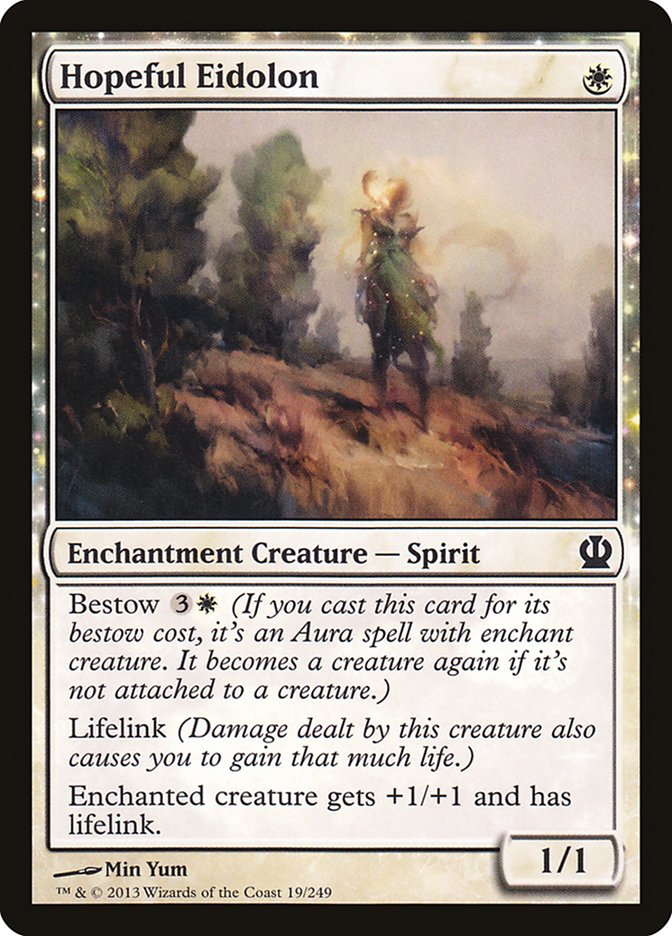
Context: All-in nature of threats
Hopeful Eidolon is one of those cards that everyone is starting to realize is insane. Even still, it isn’t getting all the love that it deserves. When I first looked at it, I was pretty unimpressed myself. I figured that since you never want to cast it as a 1/1, it just wasn’t very good. What this evaluation blinded me to is the fact that the card is basically Armadillo Cloak / Unflinching Courage. Again, a pillar of this format is building absurdly large threats. Giving a huge creature lifelink makes it so you can just keep turning that creature sideways, staying ahead of counterattacks until you win.
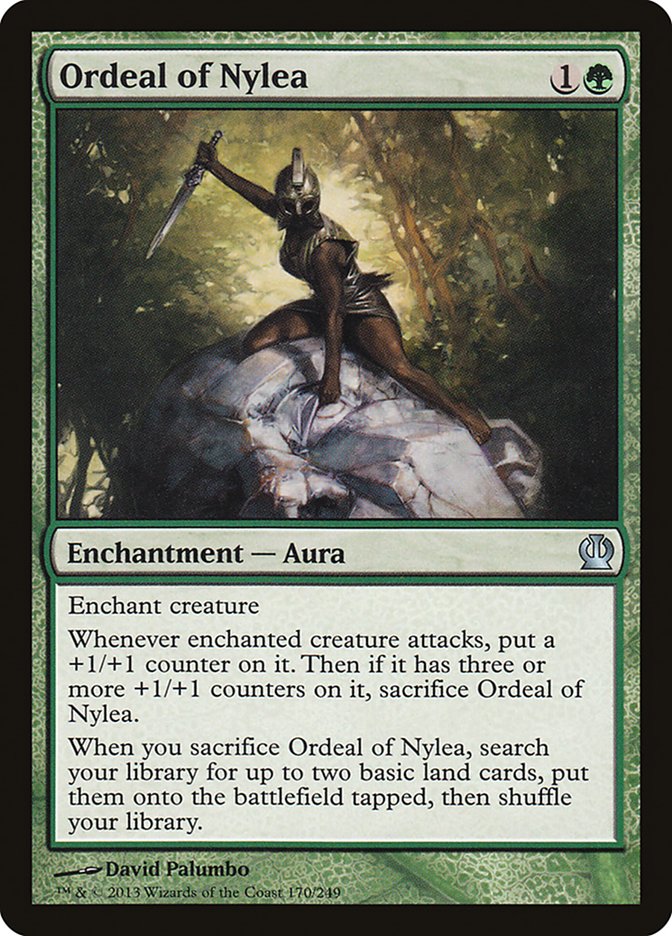
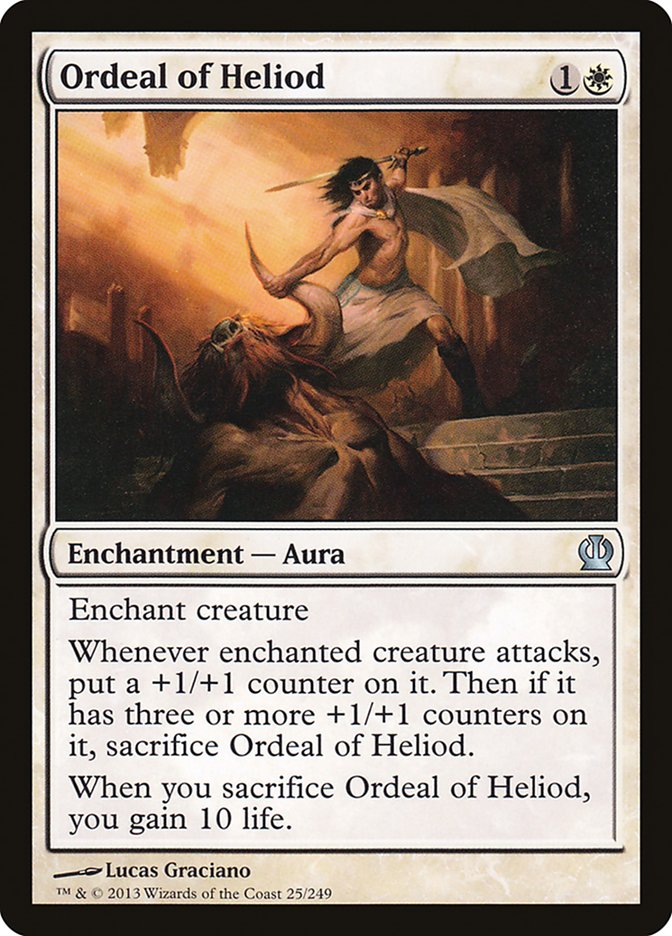
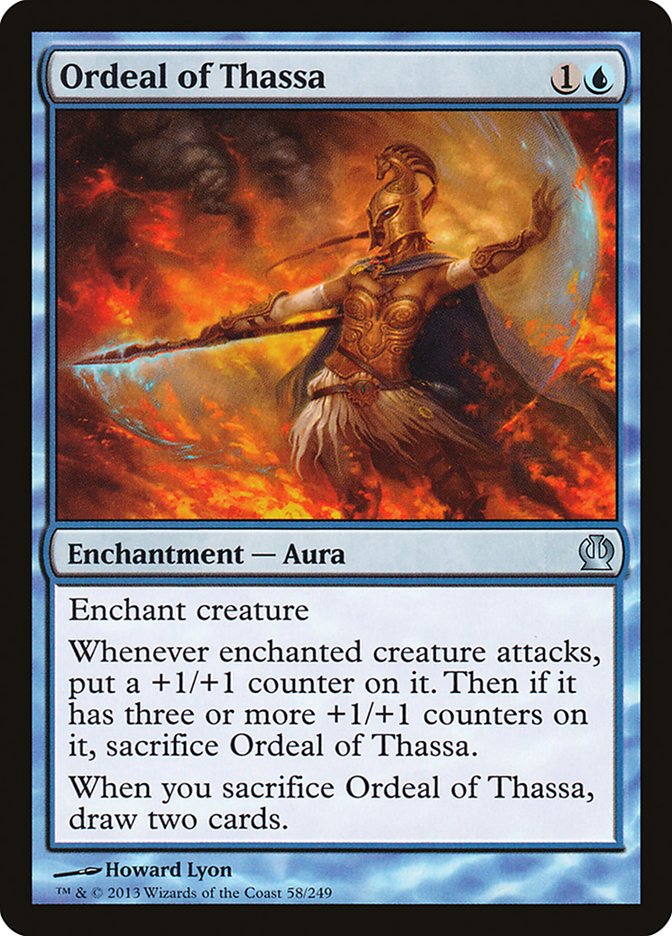
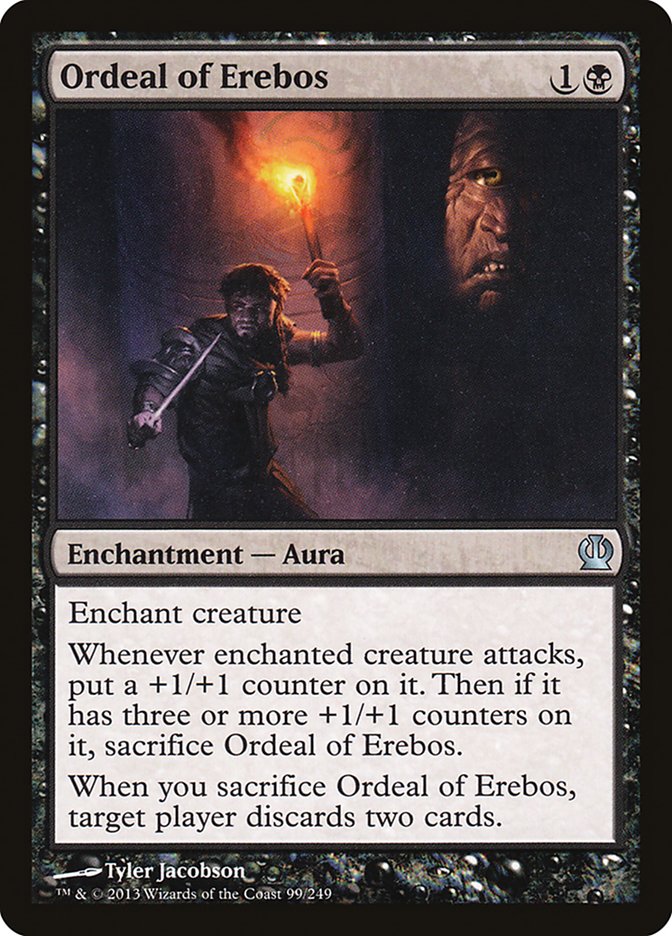
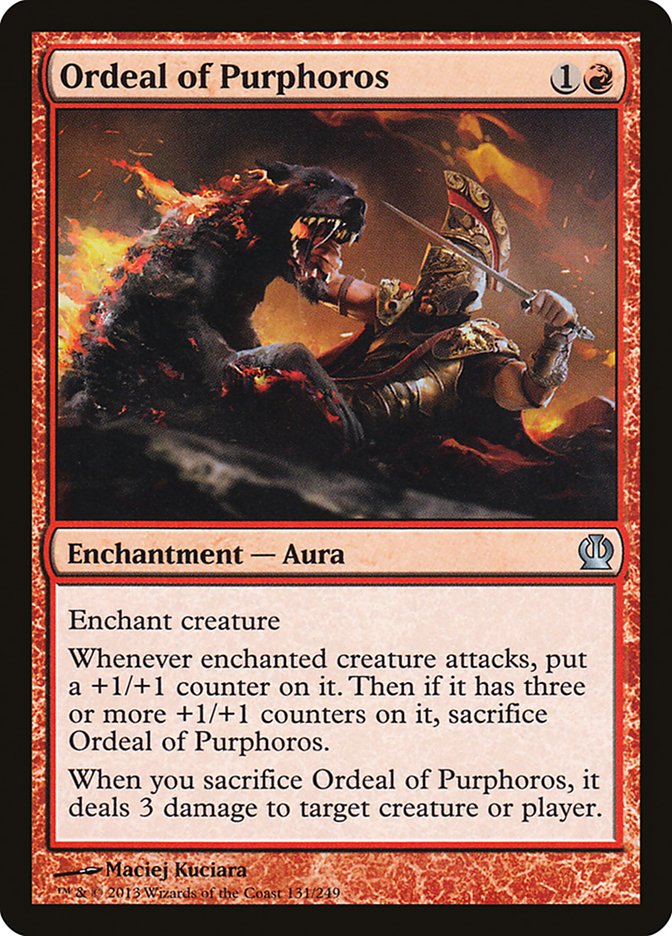
Context: Good one drops, heroic triggers, lack of removal
Assuming you can get full value out of the Ordeals, they provide very powerful effects. As it turns out, there are two very effective ways to do this in Theros. Playing a one-drop into an Ordeal is an incredibly strong start that puts your opponent under intense pressure and usually ensures a safe route to three triggers. Counting playable non-rares, White has Favored Hoplite and the aforementioned Hopeful Eidolon, black has Tormented Hero, green has Sedge Scorpion, red has Akroan Crusader and blue unfortunately has nothing of note (Triton Shorethief does not count!). As long as you don’t go mono-blue it is pretty easy to draft decks that take advantage of the one-drop into Ordeal combo.
The other way to ensure you get full value from Ordeals come from heroic triggers. As long as your Ordeal creature has three counters on it after the attack trigger, you get to sacrifice the Ordeal no matter where the counters came from. Battlewise Hoplite, Centaur Battlemaster, Favored Hoplite, Phalanx Leader, Staunch-Hearted Warrior, and Wingsteed Warrior all provide speedier Ordeal sacrifices, shortening the window of opportunity your opponent has to punish you in. Since Favored Hoplite is a one-drop with Heroic, you get the best of both worlds. This trick also works with Monstrosity counters, although by that point getting the benefit from an Ordeal is much less impactful.
Now that we’ve gotten the cards players take for granted out of the way let’s look at the cards players put too much stock into.
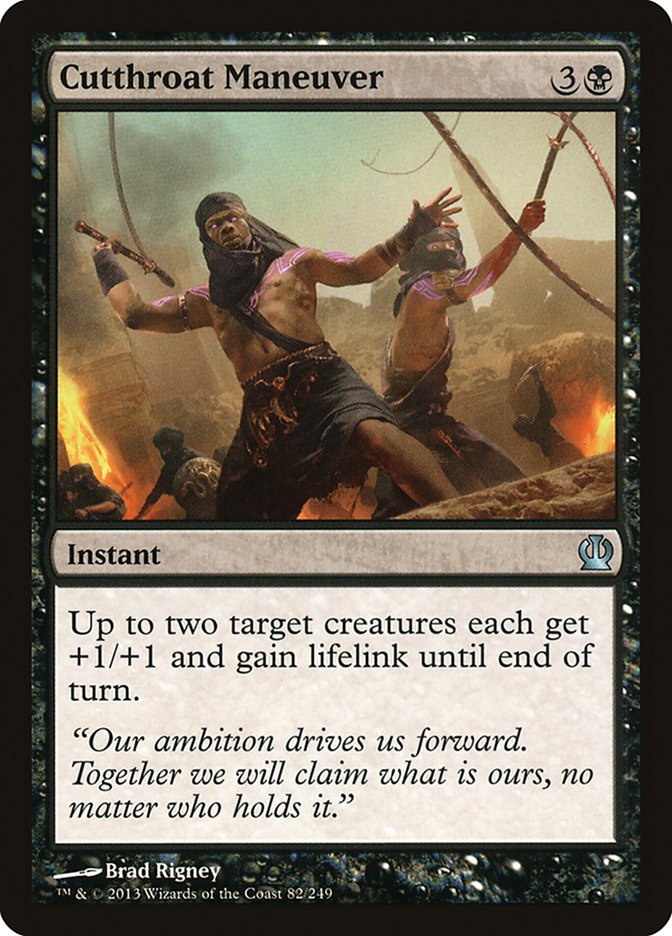
Context: Not many race situations, little Heroic in black
Players have been giving this card way too much credit. It isn’t the best combat trick, because giving creatures +1/+1 isn’t going to be strong enough to reliably win combat. Sure, it triggers Heroic, but black isn’t the color looking for that effect so you lose out on a lot of potential there. Cutthroat Maneuver is best when used as a racing tool when you have giant creatures, but most games in this format don’t come down to a race and black doesn’t have that many big creatures. All things considered, four mana is just a little too steep for me when it comes to this card.
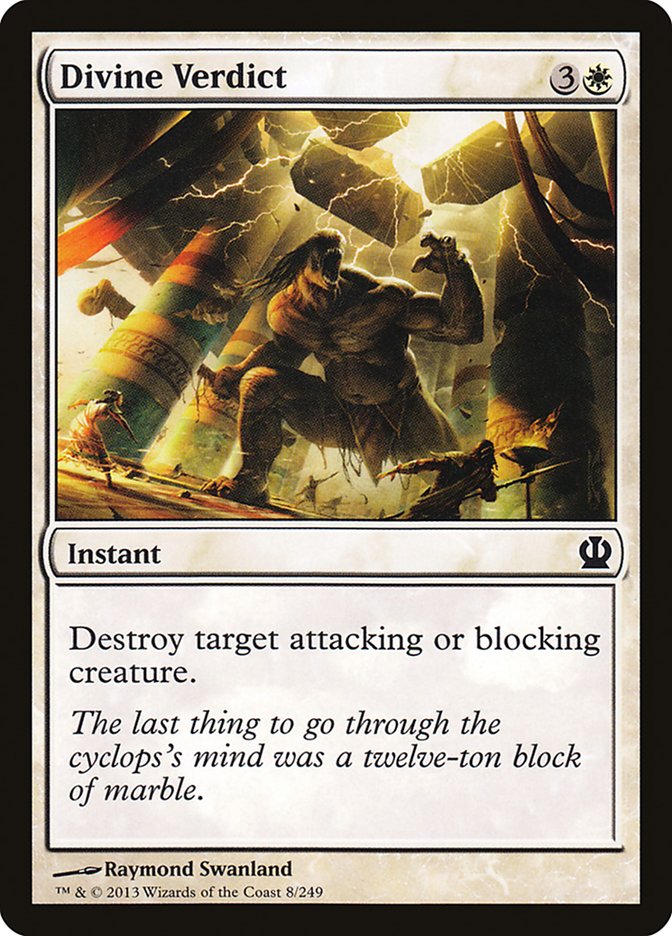
Context: Lack of responsive white instants
I truly despise this card and all cards like it. As long as your opponent has any decent grasp of the format, they should be able to see this coming from miles away and never attack into it. Holding up four mana every turn is no small price to pay, and that allows your opponent to keep building their board and not attack while you sit there and do nothing. People refer to this card as a necessary evil, but the complete lack of any other responsive white instant seals the deal for me. I keep this card in my sideboard at all times unless I’m playing a white-blue deck and can pair it with Griptide, Voyage’s End and Dissolve.
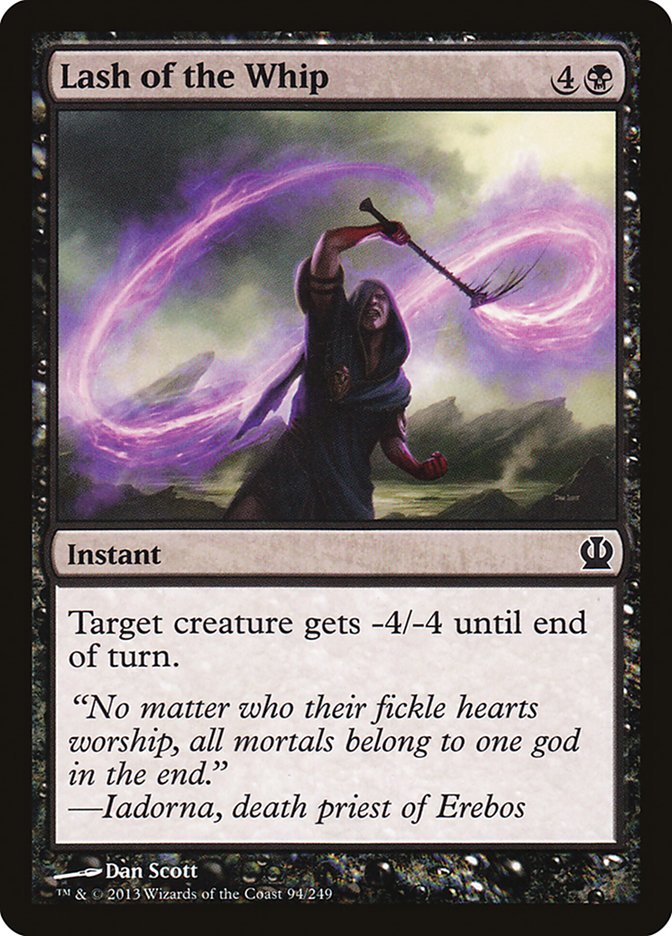
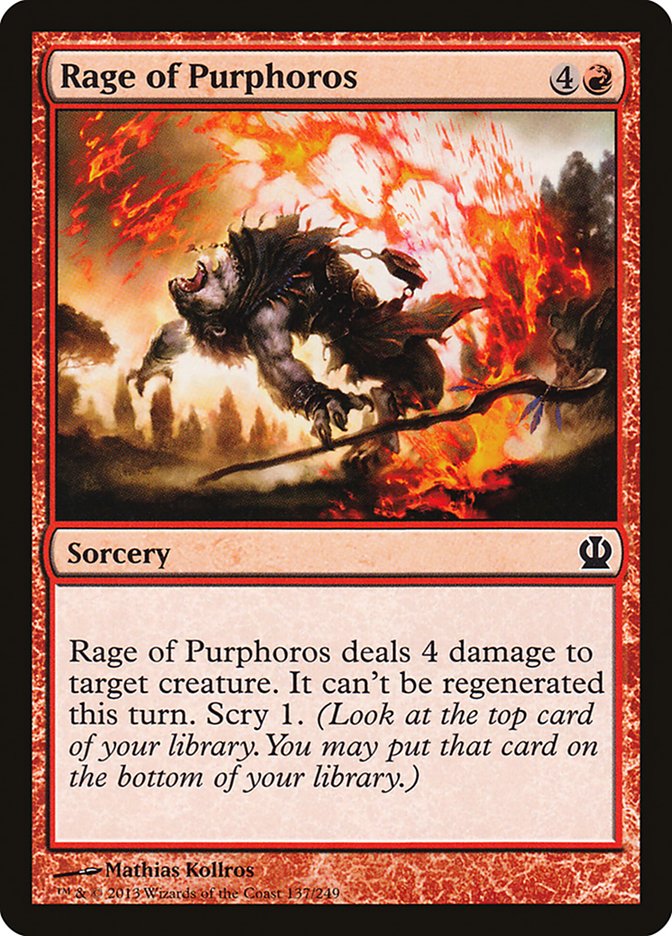
Context: Huge threats
It seems like something of a sick joke to me to put a five-mana removal spell in two colors that can’t kill anything important in the format. While that might be a bit of an exaggeration, I’ve grown to really dislike playing either of these two cards. They fall into the necessary-evil category a lot more effectively than Divine Verdict does, but not to the extent that I see some people prioritizing them. We learn from a very young Magic age that removal is always good in Limited. Sometimes, you need to break away from tradition and realize there are only so many five-mana removal spells you can play that don’t actually remove the important threats you will face.
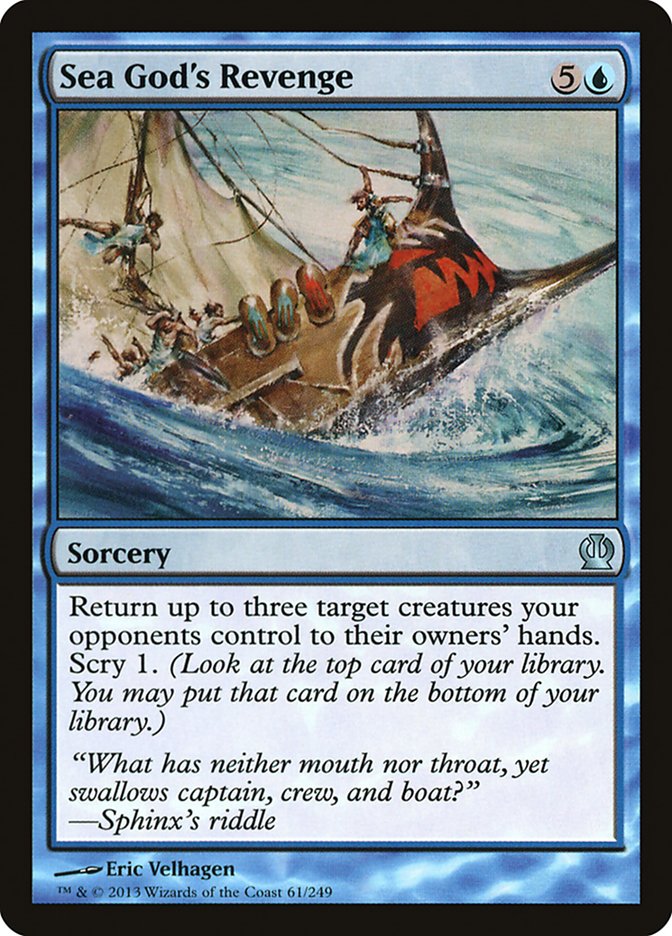
Context: Play style of blue in Theros
Before you guys start flipping out in the comments, I’m not about to say Sea God’s Revenge is bad. It is merely, like all other cards on this list, overvalued by players. Sea God’s Revenge is at its best when you can take advantage of every aspect of it. So what does bouncing creatures actually provide? It provides a massive tempo gain, clears blockers out of the way, and helps win races. In Theros, the three most potent blue combinations are blue-green, blue-black and blue-white, in no particular order. Of those three, the only combination that takes full advantage of Sea God’s Revenge is blue-green. It already has a tempo plan with cards like Griptide and Voyage’s End, it has a lot of huge ground creatures that need to get through chump blockers, and it is often winning games by racing creatures. Blue-white’s best threats already have evasion, so it doesn’t get full value from removing blockers. Blue-black has a much more controlling play style, so it isn’t concerned about winning a race. I’ve played Sea God’s Revenge in both of those archetypes successfully, but sometimes it just isn’t the best pick for your deck. Some players I see seem to be of the mindset “if I’m blue I need to take this card,” which is where the problem lies. Also, keep in mind that you can only play so many cards that cost six mana in your deck, no matter what they do.
That about wraps things up for the cards people are under/overvaluing in this limited format. Next week, I’m going to be doing a collaborative piece with fellow writer Anthony Lowry. His article this Friday is going to explain the reasons why he does not like to attend Pro Tour Qualifiers; my article next week will be going up in its usual Monday slot, and will provide my counter-argument for why I do think it is a good idea to attend Pro Tour Qualifiers.
It is going to be an interesting argument to be sure, and I’m curious to hear what you guys think about the topic. See you next week!
